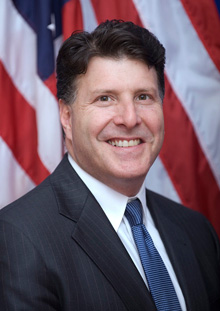Ride a bike on a sidewalk in New York City and you are subject not only to a traffic ticket, but a criminal summons. Amazingly, there is no commensurate penalty for the curb-jumping motorist, despite the potential to inflict far greater harm, and countless deaths and injuries that occur every year. Unless intoxication is a factor, prosecutions are rare -- even for crashes that result in death -- possibly in part because the act of driving on a city sidewalk is itself not a crime.
In connection with his StreetsPAC endorsement, Council Member Mark Weprin pledged to, in StreetsPAC's words, "champion legislation in the city council to ensure serious consequences for drivers who, through their own negligence, hop curbs and strike pedestrians on sidewalks." Weprin says his staff is looking into how such a bill would be crafted.
"We're going to see what the best possible solution would be," Weprin told Streetsblog. "Obviously, the circumstances need to help dictate this a little bit. People's state of mind and all of that is a big part of it, whether they were reckless in what they did or not. But when someone gets hurt someone needs to pay a price."
Attorney Steve Vaccaro, a StreetsPAC board member who represents pedestrians and cyclists, says the city needs a law based on current regulations against sidewalk bike riding, which do not require recklessness.
When a cop stops a cyclist for sidewalk riding, Vaccaro says, "There's no inquiry into whether the cyclist intended to be on a sidewalk, or disregarded a risk that they might end up on a sidewalk, or failed to perceive a risk of ending up on the sidewalk, which would be a criminal negligence standard. There's just, 'You're on the sidewalk, you're operating a bicycle.'"
"Unless you can show that someone picked you up and put you down and made you go on the sidewalk through no fault of your own, you are guilty of a misdemeanor," says Vaccaro. "That's strict liability."
Vehicular law in New York State generally disfavors strict liability, Vaccaro says, putting the burden on police and prosecutors to prove intent -- including the recent case where a driver jumped a curb and hit a parking meter and five people without stopping. "If you're not drunk, there has to be smoking gun evidence of recklessness that's shoved in the face of the police or they'll just call it a mistake." Vaccaro says. "There's this incredible disconnect."
A related argument against such a law, according to Vaccaro, is that a cyclist rides on a sidewalk purposely, while a motorist usually doesn't set out to jump a curb. But intentionality is not the only "culpable mental state" that warrants criminal charges, he says. Recklessness requires awareness of a risk (feeling a bump when a motorist's vehicle encounters a curb), and disregarding that risk (failing to hit the brakes or take other measures to avoid causing damage) constitutes a "gross deviation" from what a "reasonable person" would do. Criminal negligence, Vaccaro says, is when a driver is not aware of the risk, but the failure to perceive the risk constitutes a gross deviation of what a reasonable person would perceive.
In short, a law attaching an ipso facto charge to driving on the sidewalk would be nothing new -- NYPD hands out such summonses to cyclists every day. Vaccaro says he could see the city implementing "reasonable and incremental" penalties, such as a misdemeanor with a maximum sentence of 20 days in jail and a $300 fine, which is what cyclists face if they hit a pedestrian on a sidewalk.
Weprin is not sure yet if sidewalk driving legislation should parallel bike riding laws, because driving a car on a sidewalk is much more dangerous than sidewalk riding, among other reasons. "Obviously there are times when the person did nothing wrong, and something malfunctions, or something like that," says Weprin. "I can understand certain excuses, but generally when you drive onto the curb it's because someone did something wrong. It's rare that it's a complete innocent mistake."
Vaccaro acknowledges that "things can happen more quickly with a car than with a bicycle," and that a vehicle can, for example, be knocked onto the curb after a collision. But that's no reason to give curb-jumping drivers carte blanche.
"Let motorists have ways of explaining their presence on the sidewalk," Vaccaro says, "but force them to, and conduct an investigation so that the explanation that isn't even plausible on the surface doesn't get uncritically accepted."
Says Weprin: "The sidewalks need to be protected from drivers and motor vehicles certainly as much as they have to be protected from people who are riding bicycles."






